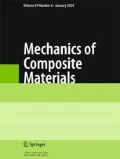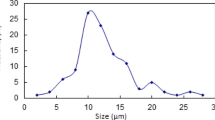A new numerical method is proposed to predict the effect of particle clustering on grain boundaries in a ceramic- particle-reinforced metal matrix composite on its mechanical properties, and micromechanical finite-element simulation of stress–strain responses in composites with random and clustered arrangements of ceramic particles are carried out. A particular material modeled and analyzed is a TiC-particle-reinforced Al matrix composite processed by powder metallurgy. A representative volume element of a composite microstructure with 5 vol.% TiC is reconstructed based on the tetrakaidecahedral grain boundary structure by using a modified random sequential adsorption. The model proposed in this study accurately represents the stress concentrations and particle-particle interactions during deformation of the powder-metallurgy-processed composite. A comparison with the random-arrangement model shows that the present numerical approach is more accurate in simulating the behavior of the composite material.
Similar content being viewed by others
References
T. Fujii and M. Zako, Fracture and Mechanics of Composite Materials, Jikkyo Shuppan, Tokyo (1978).
Z. Hashin and S. Shtrikman, “A variational approach to the theory of the elastic behaviour of multiphase materials,” J. Mech. Phys. Solids, 11, 127 (1963).
B. D. Agarwal and L. J. Broutman, Analysis and Performance of Fiber Composites, John Wiley, New York (1990).
T. Mori and K. Tanaka, “Average stress in matrix and average elastic energy of materials with misfitting inclusions,” Acta Metall., 21, 571 (1973).
J. Llorca, A. Needleman, and S. Suresh, “An analysis of the effects of matrix void growth on deformation and ductility in metal-ceramic composites,” Acta Metall. Mater., 42, 77 (1994).
Y. L. Shen, M. Finot, A. Needleman, and S. Suresh, “Effective elastic response of two-phase composites,” Acta Metall. Mater., 42, 77 (1994).
N. Chawla, B. V. Patel, M. Koopman, K. K. Chawla, R. Saha, B. R. Patterson, E. R. Fuller, and S. A. Langer, “Microstructure-based simulation of thermomechanical behavior of composite materials by object-oriented finite element analysis,” Mater. Charact., 49, No. 5, 395 (2002).
A. A. Gusev, P. J. Hine, and I. M. Ward, “Fiber packing and elastic properties of a transversely random unidirectional glass/epoxy composite,” Compos. Sci. Technol., 60, No. 4, 535 (2000).
N. Chawla, R. S. Sidhu, and V. V. Ganesh, “Three-dimensional visualization and microstructure-based modeling of deformation in particle-reinforced composites,” Acta Mater., 54, No. 6, 1541 (2006).
K. U. Kainer, “Basics of metal matrix composites” in: Metal Matrix Composites, Willy-VCH, Germany (2006).
K. S. Sohn, K. J. Euh, S. H. Lee, and I. M. Park, “Mechanical property and fracture behavior of squeeze-cast Mg matrix composites,” Metall. Mater. Trans. A, 29, 1543 (1998).
I. Gheorghe and H. J. Rack, “Powder processing of metal matrix composites” in: T. W. Clyne (ed.), Comprehensive Composite Materials. Vol. 3. Metal Matrix Composite, Cambridge University Press, London (2000).
N. Chawla and K. K. Chawla, Metal Matrix Composite, Springer, New York (2005).
J. J. Lewandowski, C. Liu, and W. H. Hunt Jr., “Effects of matrix microstructure and particle distribution on fracture of an aluminum metal matrix composite,” Mater. Sci. Eng. A, 107, 241 (1989).
A. H. Nagawa and M. N. Gungor, “Microstructure and tensile properties of Al2O3 particle-reinforced 6061 Al cast composite” in: P. K. Liaw and M. N. Gungor (eds.), Fundamental Relationships Between Microstructure and Mechanical Properties of Metal-Matrix Composites, TMS, Warrendale (1989).
N. Chawla, L. C. Davis, C. Andres, J. E. Allison, and J. W. Jones, “Effect of SiC volume fraction and particle size on the fatigue resistance of a 2080 Al/SiCp composite,” Metall. Mater. Trans. A, 29, 2843 (1998).
N. Chawla, J. J. Williams, and R. Saha, “Mechanical behavior and microstructure characterization of sinter-forged SiC particle reinforced aluminum matrix composites,” J. Light Metals, 2, 215 (2002).
J. Segurado, C. Gonzalez, and J. Llorca, “A numerical investigation of the effect of particle clustering on the mechanical properties of composites,” Acta Mater., 51, No. 8, 2355 (2003).
D. F. Watt, X. Q. Xu, and D. J. Lloyd, “Effects of particle morphology and spacing on the strain fields in a plastically deforming matrix,” Acta Mater., 44, No. 2, 789 (1996).
A. M. Murphy, S. J. Howard, and T. W. Clyne, “Characterisation of severity of particle clustering and its effect on fracture of particulate MMCs,” Mater. Sci. Technol., 14, Nos. 9-10, 242 (1998).
A. Borbely, H. Biermann, and O. Hartmann, “FE investigation of the effect of particle distribution on the uniaxial stress–strain behaviour of particulate-reinforced metal-matrix composites,” Mater. Sci. Eng. A, 34, 313 (2001).
X. Deng and N. Chawla, “Modeling the effect of particle clustering on the mechanical behavior of SiC-particle-reinforced Al matrix composites,” J. Mater. Sci., 41, 5731 (2006).
J. C. Honore, P. Mele, and L. Flandin, “Influence of fibre clustering on the transverse mechanical behaviour of polypropylene/glass fibre composites: experimental approach and modeling,” J. Phys. D.: Appl. Phys., 40, 6768 (2007).
A. Ayyar, G. A. Crawford, J. J. Williams, and N. Chawla, “Numerical simulation of the effect of particle spatial distribution and strength on the tensile behavior of particle-reinforced composites,” Comput. Mater. Sci., 44, 496 (2008).
J. Segurado, C. Gonzalez, and J. Llorca, “A numerical investigation of the effect of particle clustering on the mechanical properties of composites,” Acta Mater., 51, 2355 (2003).
B. Widom, “Random sequential addition of hard spheres to a volume,” J. Chem. Phys., 44, 3888 (1966).
J. Choi, S. Park, B. Park, I. Park, and Y. Park, “Characterization of hypereutectic Al-20wt% Si/TiCp metal matrix composite,” Int. J. Modern Phys. B, 23, Nos. 6-7, 1491 (2009).
S. Kari, H. Berger, and U. Gabbert, “Numerical evaluation of effective material properties of randomly distributed short cylindrical fibre composites,” Comput. Mater. Sci., 39, No. 1, 198 (2007).
J. L. Johnson and R. M. German, “Theoretical modeling of densification during activated solid-state sintering,” Metall. Mater. Trans., 27, No. 2, 441 (2007).
Y. Nakasone, S. Yoshimoto, and T. A. Stolarski, Engineering Analysis with ANSYS Software, Butterworth-Heinemann, Oxford (2007).
L. Mishnaevsky Jr., “Methods of the theory of complex systems in modeling of fracture: a brief review,” Eng. Fract. Mech, 56, No. 1, 47 (1997).
L. Mishnaevsky Jr., K. Derrien, and D. Baptiste, “Effect of microstructure of particle reinforced composites on the damage evolution: probabilistic and numerical analysis,” Compos. Sci. Technol., 64, 1805 (2004).
Author information
Authors and Affiliations
Corresponding author
Additional information
Russian translation published in Mekhanika Kompozitnykh Materialov, Vol. 46, No. 6, pp. 931-942, November-December, 2010.
Rights and permissions
About this article
Cite this article
Lee, W.J., Kim, Y.J., Kang, N.H. et al. Finite-element modeling of the particle clustering effect in a powder-metallurgy-processed ceramic-particle-reinforced metal matrix composite on its mechanical properties. Mech Compos Mater 46, 639–648 (2011). https://doi.org/10.1007/s11029-011-9177-y
Received:
Published:
Issue Date:
DOI: https://doi.org/10.1007/s11029-011-9177-y




